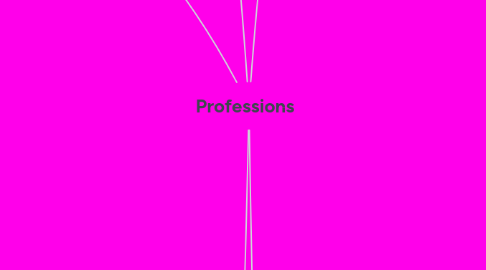
1. Help select, fit, and dispense hearing aids and other amplification devices.
2. Audiologists
2.1. Education
2.1.1. Doctorate degree/Au.D
2.1.2. Certificate of Clinical Competence: (CCC-A)
2.1.2.1. Supervised clinical experience
2.1.3. Passing Score on National Exam
2.1.4. State license in practicing state
2.2. Work Settings:
2.2.1. Educational Settings
2.2.2. Hospitals
2.2.3. Clinics
2.2.4. Government Agencies
2.2.5. Industries
2.3. Scope of Practice
2.3.1. Audiologists work with people who suffer from a hearing disorder: auditory processing disorder (APD), hearing loss, hard of hearing, and deafness.
2.3.1.1. Population
2.3.1.1.1. Young age: hearing is screened at birth. Hearing deficits usually occur since birth. Help fit children for cochlear implants and hearing aids.
2.3.1.1.2. Mid Age: Age related hearing loss. Provide hearing aids. Audiologist provide hearing safety education to prevent hearing loss when older.
2.3.1.1.3. 65 years and older: Hearing loss caused by older age, loud noise exposure throughout the years, and/or diseases, and medications. Help fit for hearing aids.
2.3.2. Measure hearing ability
2.3.3. Use evidence-based practice to identify, assess, manage, and prevent disorders of hearing and balance.
3. Speech, Language, and Hearing Scientists
3.1. Education:
3.1.1. Doctorate: PhD or EdD in the field.
3.2. Work Setting:
3.2.1. Universities
3.2.2. Government agencies
3.2.3. Industry
3.2.4. Research centers
3.3. Scope of Practice:
3.3.1. Their main goal is to extend the knowledge of human communication processes and disorders in order to help clinicians better serve their population.
3.3.1.1. Population
3.3.1.1.1. Serve all populations:
3.3.2. Research of speech-sound production, nature of sound, and hearing.
3.3.3. Technology related research to help improve communication with clients who are unable to speak and/or hear. (ex: AAC device, hearing tests, hearing amplifiers, and hearing aids.)
3.3.4. They study different languages to get better insight on how language is developed.
4. Speech Language Pathologist
4.1. Education:
4.1.1. Master's or Doctorate degree/Ph.D
4.1.2. Certificate of Clinical Competence: (CCC-SLP)
4.1.2.1. 25 hours of clinical observation.
4.1.2.2. 350 hours of clinical practice
4.1.2.3. 9 months of supervised clinical experience (CFY)
4.1.3. Passing score on National SLP Exam (NTE)
4.1.4. State license in practicing state
4.1.5. For school SLP: National Teaching Certificate
4.1.6. Continuing Education (CEU)
4.2. Work Settings:
4.2.1. School Systems
4.2.2. Hospitals
4.2.3. Rehabilitation Centers
4.2.4. Clinics
4.2.5. Nursing Homes
4.2.6. Independent Practice
4.3. Scope of Practice:
4.3.1. Help people who suffer from a communication disorder: speech; language(receptive/expressive); cognitive/social disorders.
4.3.1.1. Population:
4.3.1.1.1. Young Children
4.3.1.1.2. Mid-age
4.3.1.1.3. 65 years and older
4.3.2. Help people who have swallowing and feeding difficulties
4.3.3. Help with accent modification
4.3.4. Use evidence-based practice to identify, access, treat, and prevent communication disorders.
5. Professional Aids
5.1. Speech-Language Pathology Assistants
5.1.1. Education:
5.1.1.1. Associates degree in an SLPA program
5.1.1.2. Or a Bachelor's degree in communication disorders program/or SLP program
5.1.1.3. Minimum 100 hours of supervised field work experience
5.1.1.4. Passing score on SLPA exam
5.1.2. Work Setting: work wherever a credentialed SLP is found.
5.1.2.1. Schools
5.1.2.2. Clinics
5.1.2.3. Hospitals
5.1.2.4. Rehabilitation Centers
5.1.3. Scope of Practice:
5.1.3.1. Assist SLP's with helping populations who suffer from communication disorders. They work alongside an SLP and are supervised.
5.1.3.1.1. Population:
5.1.3.2. Clerical and therapy related tasks.
5.1.3.3. Assist with prepping assessments and treatment materials.
5.2. Audiology Assistants
5.2.1. Eudcation
5.2.1.1. Minimum requirement: High School Diploma
5.2.1.2. Training program completion
5.2.1.3. License/ registration may be required depending on the state.
5.2.2. Work Setting: work wherever a credentialed Audiologist is found.
5.2.2.1. Schools
5.2.2.2. Government Agencies
5.2.2.3. Clinics
5.2.2.4. Industries
5.2.3. Scope of Practice:
5.2.3.1. Assist Audiologists with helping populations with hearing disorders. They must be supervised by a credentialed Audiologist.
5.2.3.1.1. Population:
5.2.3.2. Conduct clerical tasks and hearing screenings.
5.2.3.3. Manage equipment and materials such as: hearing aids.

